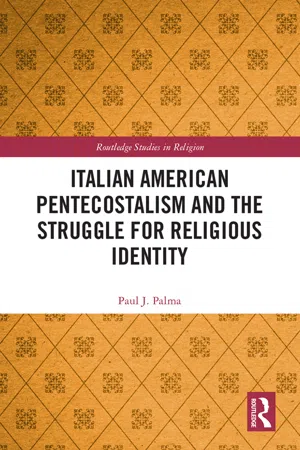
- 254 pages
- English
- ePUB (mobile friendly)
- Available on iOS & Android
Italian American Pentecostalism and the Struggle for Religious Identity
About This Book
While many established forms of Christianity have seen significant decline in recent decades, Pentecostals are currently one of the fastest growing religious groups across the world. This book examines the roots, inception, and expansion of Pentecostalism among Italian Americans to demonstrate how Pentecostalism moves so freely through widely varying cultures.
The book begins with a survey of the origins and early shaping forces of Italian American Pentecostalism. It charts its birth among immigrants in Chicago as well as the initial expansion fuelled by the convergence of folk-Catholic, Reformed evangelical, and Holiness sources. The book goes on to explain how internal and external pressures demanded structure, leading to the founding of the Christian Church of North America in 1927. Paralleling this development was the emergence of the Italian District of the Assemblies of God, the Assemblee di Dio in Italia (Assemblies of God in Italy), the Canadian Assemblies of God, and formidable denominations in Brazil and Argentina. In the closing chapters, based on analysis of key theological loci and in lieu of contemporary developments, the future prospects of the movement are laid out and assessed.
This book provides a purview into the religious lives of an underexamined, but culturally significant group in America. As such, it will be of great interest to scholars of Pentecostalism, Religious Studies and Religious History, as well as Migrations Studies and Cultural Studies in America
Frequently asked questions
Information
Part I
Through the fire

1
“Tongues of fire”
Early Christian spirituality
Medieval renewal
Patron saints of Italy
Table of contents
- Cover
- Half Title
- Series Page
- Title
- Copyright
- Dedication
- Contents
- List of figures
- List of photo essay
- List of tables
- Acknowledgements
- List of abbreviations
- Introduction
- PART I Through the fire: the historical contours of Italian American Pentecostalism
- PART II Theological trajectories of Italian American Pentecostalism
- Conclusion: “To the Jew first and also to the Greek”
- Epilogue
- Bibliography
- Appendix A: CCNA “Articles of Faith” (1997)
- Appendix B: IPCC “We Believe” Statement (1993)
- Appendix C: Article 12 of the ADI’s “Articles of Faith” (Articoli di fede) statement (1999)
- Index